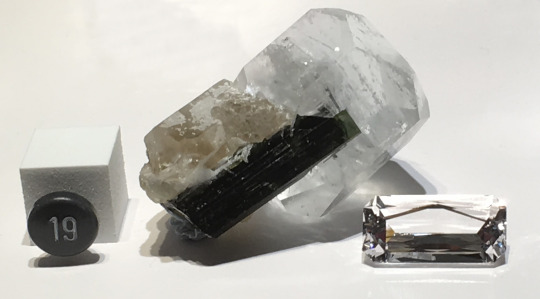
Beryl has many different varieties that you may be familiar with, the most recognized being: Emerald (green), Heliodor (yellow), Morganite (pink), and Aquamarine (blue or blue-green). One that you may not be familiar with is Red Beryl, a very rare variety of the species. The red is due to the trace element manganese. Red Beryl occurs in only a few places in the world and of those localities, only one of them produces crystals of the size and quality suitable for cutting gemstones, namely the Ruby Violet claims in the Wah Wah Mountains in Beaver County, Utah. For over a dozen years the Section of Minerals & Earth Sciences staff have been on the lookout for a faceted Red Beryl to put on display in the Beryl as a Gemstone exhibit in Wertz Gallery: Gems and Jewelry. But, alas, most of the Red Beryl gemstones on the market are very small because nearly all the gem rough that is produced is less than a carat in size. Faceting rough of that size usually yields gemstones of only ¼ to ½ carat, which would be too small to use in the exhibit. Occasionally we have come across gemstones of around one carat, but they were not of high enough quality for the exhibit due to poor color, poor cut, or numerous inclusions. But, as luck would have it, in March of this year I was able to acquire from Pala International a worthy, cushion cut Red Beryl gemstone with the amazing size of 2.45 carats! Together with the crystal from the same locality (acquired two years ago from Collector’s Edge) we now have a stunning rough & cut pair to represent the variety Red Beryl in the Beryl as a Gemstone exhibit.

Another lesser known variety of Beryl is Goshenite, which is colorless. When Wertz Gallery opened in September of 2007 the Beryl as a Gemstone exhibit had a nice crystal of Goshenite on display from Pakistan but lacked a cut gemstone from Pakistan to go with it. In May, I acquired a beautiful 5.06 carat emerald cut Goshenite from Dudley Blauwet Gems to complement the crystal. Now every crystal on display in that exhibit has an accompanying gemstone.

Both of these new gemstones were placed on exhibit in Wertz Gallery on June 4, 2019, so stop by and see them in the Beryl as a Gemstone case!
Debra Wilson is the Collection Manager for the Section of Minerals at Carnegie Museum of Natural History. Museum employees are encouraged to blog about their unique experiences and knowledge gained from working at the museum.
